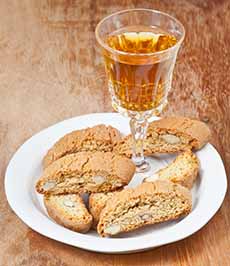|
It’s National Drink Wine Day. But let’s expand our American horizons to a different slant: pairing wine with sweet foods.
> The history of wine is below.
Also check out:
Pairing Wine & Cake
Pairing Wine & Chocolate
Pairing Wine & Desserts
Pairing Wine With Ice Cream & Sorbet
A bonus:
Pairing Beer & Chocolate
NOW IT’S TIME TO PARTY!
What should you do with these wine-and-sweet-food pairings? Have a party, of course!
Pick your theme, then invite friends to a dessert potluck.
> The History Of Cake
> The History Of Chocolate
> The History Of Ice Cream
A BRIEF HISTORY OF WINE
The oldest evidence of fruits and grains fermented into alcoholic drinks is found in China, around 9,000 years ago. Here’s a timeline.
7000-6600 B.C.E. in China. People in the Yellow River Valley (Henan province) made a fermented wine of rice, fruit, and honey. It was stored in earthenware jars.
4,000 B.C.E. in the Middle East. Wine making facilities are discovered in excavations in Armenia, Georgia, Iran and Israel. The wine was stored in large earthenware vessels submerged in the ground.
1600–1100 B.C.E. in the Middle East. Evidence of wine transported in clay amphorae and goatskins, in Assyria, Egypt, and Mesopotamia.
1400 B.C.E. in the Middle East. Amphorae become the primary container to ship wine in ancient Israel and Greece.
|
|

[1] Enjoy a late harvest Muscat with your cake(photo © PantherMedia Stock Agency | Vadim Vasenin).

[2] Vin santo, a Tuscan dessert wine served with cantucci (shorter biscotti) have long been a popular dessert in Italy. (photo © PantherMedia Stock Agency | Valery Vvoennyy.
|
|
1500–1200 B.C.E. Greece. Clay tablets written in Linear B, the ancient Greek transcript, include messages about vines and wine.
900 B.C.E. Northern Europe. During the Iron Age in Gaul, barrels become the preferred container to store and ship wine.
900–100 B.C.E., Greece & Rome. Clay amphorae remain the preferred container to store and transport wine.
206 B.C.E.-220 C.E., China. Wine begins to be produced in China in the Han dynasty.
77 C.E., Rome. Pliny the Elder writes “Vino Veritas” (“In wine, there is truth”) in his Naturalis Historia (Natural History).
1000, France. Château de Goulaine is built in the Loire Valley. Home to the family of the marquis de Goulaine for more than 1,000 years, it still makes wine and is possibly the oldest extant winery.
15th and 16th centuries, Germany. Wines that may have been sealed and stored in stoneware jugs re-ferment, creating wines with spritz. This creamy or “crémant” style led to the creation of French sparkling wine and British cider.
Late 1500s, Southern Europe. The wine was preserved for long shipping journeys through fortification: adding alcohol. Higher alcohol meant better preservation, and led to the creation of Madeira, Marsala, Port, and Sherry. (I.P.A. beer was created for the same reason: to be shipped long distances, in this case to India).
1600s, Europe. Sweet wines are the most highly prized: Riesling from Germany, Sauternes from Bordeaux, and Tokaji from Hungary*.
1600s, Portugal. Glass wine bottles were first popularized to age Port wines.
1650, France. Somewhere in Bordeaux, Cabernet Franc and Sauvignon Blanc naturally cross to create Cabernet Sauvignon.
1659, South Africa. Grapevines are first introduced to the area around Cape Town, leading to the creation of the great sweet wine Vin de Constance. It is said that Louis XVI and Marie Antoinette had more bottles of it in their cellars at the Palace of Versailles than French Burgundy. In the U.S., John Adams and George Washington were great fans of the wine. Napoleon Bonaparte spent his exile on St. Helena drowning his sorrows in Vin de Constance. Jane Austen wrote that “the finest old Constantia wine is the perfect remedy for a disappointed heart.” French poet Charles Baudelaire compared his lover’s kiss to both opium and the finest Constantia wine [source].
1776, Philadelphia. Madeira was the wine enjoyed at the signing of the Constitution.
1737, Hungary. Tokaj, in the foothills of the Zemplén Mountains, becomes the world’s first demarcated wine region. It was done to protect the sweet white wine making tradition of Tokaji Aszú, the world’s oldest sweet wine, which had then been made for nearly 1000 years.
1740s-1820s, Europe. Wine bottles were redesigned to be laid on their side, creating the ability to age wines long term. Glass bottles began to be used in the 17th century, although they were squat, with large bases and short necks. They were stood up straight for storage; but stored this way, the corks dry out. By the 1820s wine bottles resembled the traditional ones we use today [source].
1857, California. The first commercial winery, Buena Vista Winery, is established in Sonoma County. It is still in business.
Mid-1800s, France. Sparkling wines are popularized in the Champagne region, partially due to consistency in wine bottle manufacturing that can withstand the pressure of the bubbly.
1860s, Italy. Europeans still love sweet wines: The red wines of Barolo, today the most tannic and masculine of wines, are sweet.
1890, U.S. Zinfandel is the most planted grape in America.
1860-1900, France. Some 70% of Europe’s vineyards are killed by Phylloxera astatrix, a microscopic, aphid-like insects. Vineyards were replanted with hybrid wines that crossed the Vitis vinifera with resistant species.
1920–1933, U.S. Prohibition is enacted. It is illegal to make and sell wines, except for a fraction needed for medicinal and religious purposes.
1950s, U.S. Personnel returning from the war in France lead to the import and popularization of French wines.
1965, Australia. Bag-in-a-box wine is invented by Australian winemaker Thomas Angove.
1978, U.S. Robert Parker launches The Wine Advocate, a consumer newsletter that uses a novel 100-point wine rating system.
2000. France is the world’s largest producer of wine in the world. Italy is second.
2010. Cabernet Sauvignon is the world’s most planted wine grape.
2013. China becomes the world’s largest consumer of dry red wines in the world [source].
Present, China. Thanks to its immense territory and favorable climates, China is the largest grape producer worldwide, contributing to nearly half of the world’s grape production [source].
________________
*Cleopatra had a penchant for Muscat Of Alexandria, a sweet white wine that is still made today. The grape originated in North Africa, and was cultivated extensively on the island of Lemnos in the North-Eastern Aegean region of Greece. Cleopatra’s wine purportedly came from there (around 40 B.C.E.).
CHECK OUT WHAT’S HAPPENING ON OUR HOME PAGE, THENIBBLE.COM.
|

